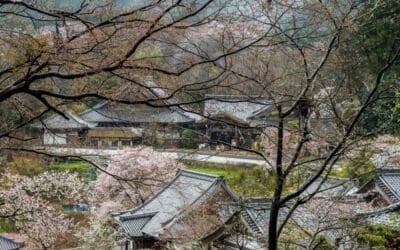The path to revitalizing Japan’s countryside is often littered with proposals that die in committee meetings. There is, however, a better way—a strategy that champions creation over consensus. For any creative rural Japan project, the answer lies not in asking permission but in building a tangible prototype that proves the concept from day one. This new model, often defined by the agile and visionary spirit of independent Japan filmmaking, prioritizes momentum and brings an idea to life before it can be diluted by bureaucracy.
For instance, consider Those Who Cross the Stillness, a winter music video filmed in Shinano, Nagano. This project did not begin with a schedule or a funding request. Instead, it emerged from a singular vision to capture the profound quiet of a snow-covered forest. As elemental spirits seem to approach from unseen paths, the film powerfully demonstrates what happens when atmosphere leads and agenda follows. Indeed, it is a raw, compelling example of what agile filmmaking can achieve when a creator builds with speed and clear intent.
This film is, in essence, a powerful proof of concept. A filmmaker created it quickly to showcase an idea, which consequently sets it apart from the vast majority of regional initiatives. It doesn’t ask the viewer to imagine what could be; it shows them directly. For this reason, by using focused rural story development, the film evokes a deep sense of emotion and place, making the potential of the region tangible.
The Flaw in the Traditional Path
Why good ideas die in the waiting room.
In most regional development scenarios, the process is painfully predictable. An idea is born, and a team immediately translates it into a pitch deck or proposal. The team then circulates this document among committees, local government officials, and potential sponsors. As a result, weeks turn into months. The initial spark of creative energy fades as feedback loops and bureaucratic inertia bog it down. By the time everyone finally agrees on a watered-down version of the original concept, the project’s momentum is entirely gone.
This reliance on consensus actively prevents true innovation. In fact, it favors safe, predictable projects over bold, visionary ones. While designers created the system to minimize risk, in doing so, it also minimizes impact. For creative rural Japan, a landscape brimming with unique stories and untapped potential, this outdated model is a critical failure. It clings to timelines and technologies that actively stifle the very creativity it claims to support.
The Power of the Solo-Built Prototype
Building with speed, rhythm, and intention.
In contrast, the Shinano film directly responds to this systemic failure. A single person produced the entire project. There was no large crew, no administrative overhead, and no bureaucracy. Instead, there were only the essential elements: tools, weather, rhythm, and intention. This approach is the very bedrock of what independent Japan filmmaking offers—complete control over tone, speed, and the final message.
A compelling prototype was created in less time than it takes to coordinate a single stakeholder meeting.
-
It Communicates More Clearly: A finished work conveys emotion and vision far more effectively than any presentation.
-
It Forces a Practical Vision: Moreover, the act of building something forces the creator to solve real-world problems, making the idea stronger.
-
It Maintains Creative Integrity: A solo vision remains pure and undiluted by committee-driven compromises.
The creator of Those Who Cross the Stillness chose the forest as its setting not for logistical reasons, but for symbolic ones. The forest becomes a metaphor for untapped possibility and the raw beauty of the countryside. Therefore, the film itself stands as a live demonstration of how creative rural Japan projects can get built when guided by a clear and singular vision.
Media First, Stakeholders Later
Shifting the conversation from imagination to reaction.
Conventional wisdom tells creators to get buy-in before they build. The prototype model, however, reverses this entirely: make first, align second. The purpose of creating a media prototype—be it a short film, a photo series, or an audio experience—is to create an asset that carries the emotional weight of the idea. Consequently, when you walk into a room with a powerful piece of media, the conversation changes completely.
You are no longer asking stakeholders to use their imagination. You are asking them to react to something that already exists. This shift is fundamental. Discussions become more productive because they are grounded in a shared reality, not an abstract concept. This is how the Akiyaz model operates. We use speed and clarity to test visions in the real world. Ultimately, a story doesn’t need a committee to get started. It just needs someone to make something good enough that others are inspired to build around it.
The Akiyaz Model in Action
Using rural story development to make spaces emotionally relevant.
The Shinano winter project is more than just an art piece; it is a working proof of a potent strategy. It leverages the spirit of independent Japan filmmaking and rural story development to position a physical space as emotionally relevant, not just spatially available. Furthermore, this is the key to unlocking the true potential of creative rural Japan.
This approach applies far beyond filmmaking. Imagine, for example:
-
A Tourism Concept: Instead of a brochure, create a short, immersive video that captures the feeling of a local festival or a walk through an ancient town.
-
A Product Idea: Before sourcing materials for a new local craft, develop a stunning photo series that tells the story of the artisans and the landscape that inspires them.
-
A Cultural Experience: Rather than a written plan, design a soundscape that simulates the atmosphere of a proposed cultural event or installation.
The goal is to bypass the failure of imagination by providing direct proof of the concept. By leading with a well-crafted prototype, you give your vision the traction it needs to attract partners, funding, and community support.



